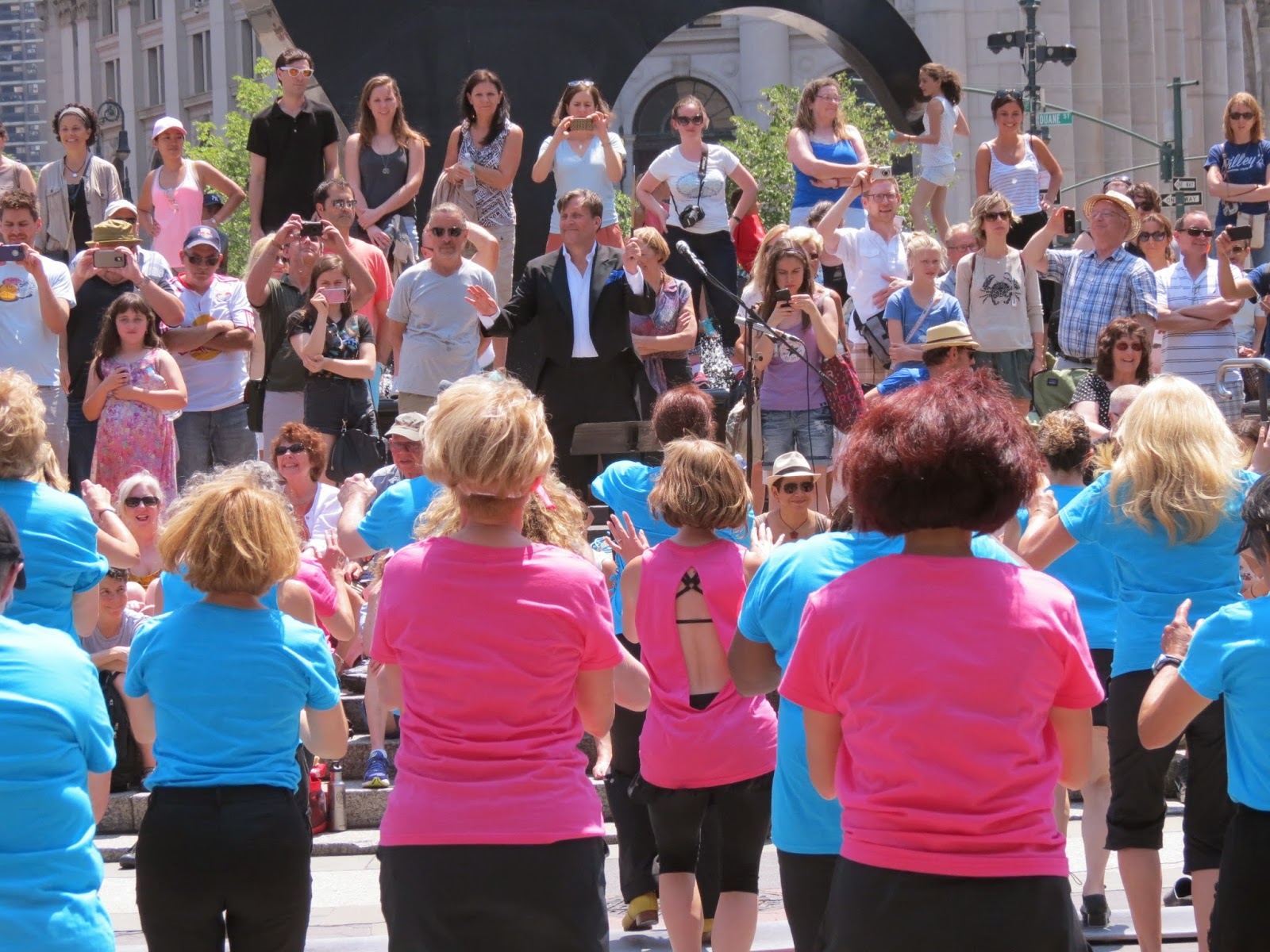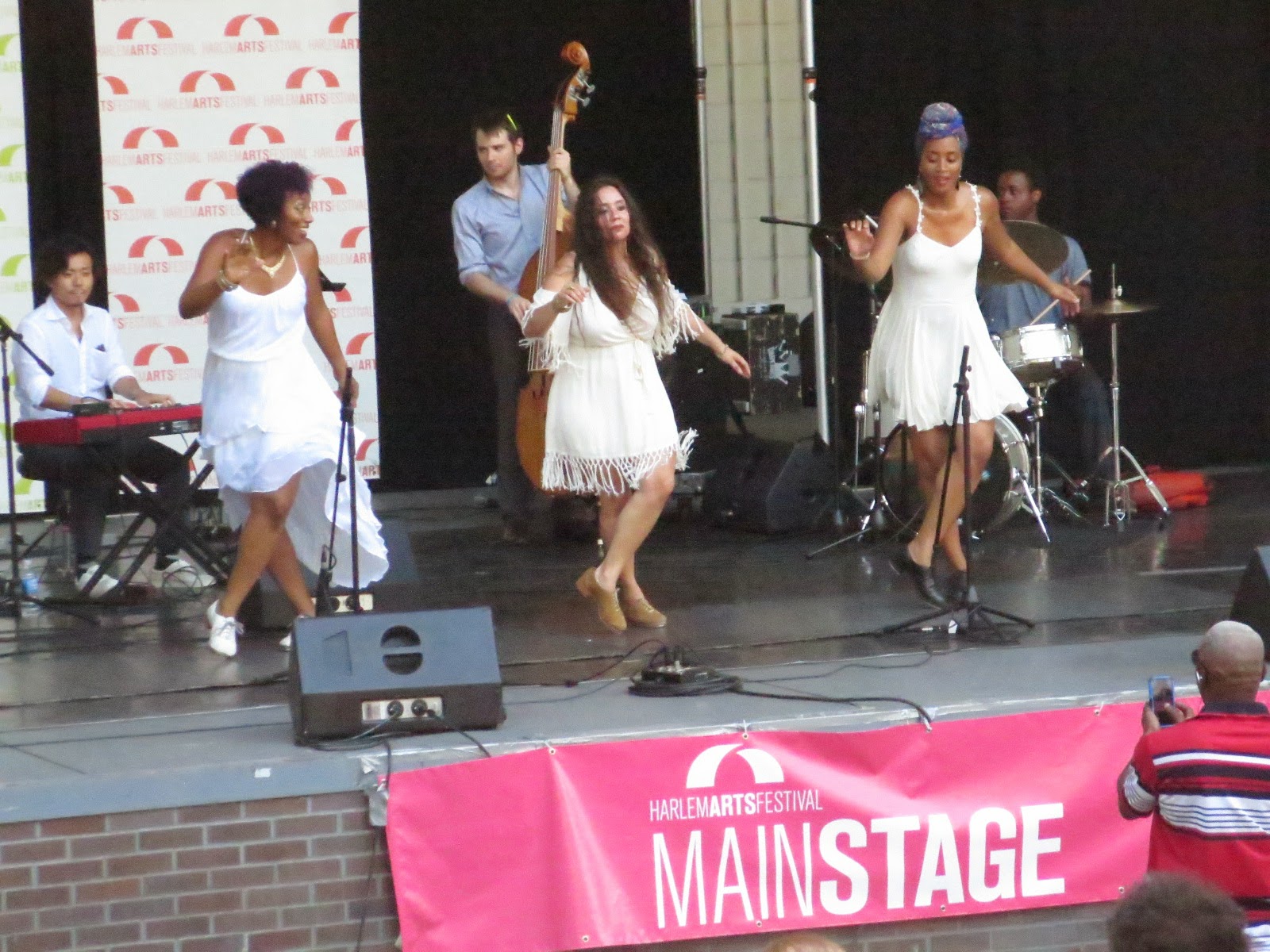Well, it's been about six months, but here are some of my current thoughts on tap. I've been thinking about tradition, ancestry and spirit a lot these days and in the past month, or so, I attended three tap events that relate to these thoughts.
The American Tap Dance Foundation's annual New York City Tap Festival, better known as Tap City, ended on Saturday July 12th with an out door event called "Tap It Out". A large group tap dancers
performed different tap numbers "conducted" by Tony Waag, Artistic Director of the Festival. There were three sets of dance and it was great fun to watch. Last year it was held at Duffy Square in the Theater District but this year was held in Foley Square near the court buildings in lower Manhattan. This spot was chosen because it is near where Paradise Square existed in the mid 1800s as part of the Five Points district. Irish immigrants and free Africans lived in this district. One free black man, named William Henry Lane, lived and performed in this area and is credited by many as the person who helped fuse African and Irish dance styles to create the beginnings of what we know as tap
 |
| Tong Waag leading the tappers. Photo: Hank Smith |
dance. Most tappers know he was also known as "Master Juba". So tap was literally brought back to its roots at this event. The dancers had fun and ranged in age from youngsters to more "seasoned" folks. As I watched, I realized it was just round the corner from the African Burial Grounds and I felt the need to go to the grounds after the performance. I went with two friends and we walked down into the memorial there. I couldn't help remembering the uproar that happened in 1991 when the site was discovered as a result of digging up that area to put up a huge building. I felt so aware of its connection to what I had just seen with the tap and felt some emotion rising in me as I walked around the site. The parks ranger there started giving us a brief talk about the grounds and its history and as he spoke, some parents and young dancers from the tap event walked by, stopped and listened. The ranger was very animated and good at his talk and I was glad to see these youngsters, none of whom were African American, really pay attention to him and ask questions. I even said to them, "You see, this is why you were near here tap dancing. This is part of its history for you to know". If you've never been, you should check it out. Here is the link: http://www.nps.gov/afbg/index.htm
On the previous Sunday, July 6th, I went to see Savion Glover's annual (well, almost annual) engagement at the Joyce Theater. The evening was called "Om". I normally like to sit in the middle or back of an audience and not way up front, because I usually like to see the overall picture of stage and audience. But with Savion's Joyce shows I like being up front and for this, and his last show, I was in the front row. There are two reasons I like that location; it's only $10 and I like seeing close up what's happening with him and his colleagues on stage. At the beginning of the show, music (a Kenny Garrett piece in the spiritual style of John Coltrane) plays for a long time before the curtain rises. On the stage, dimly lit only with votive candles, are pictures of various tap dancers and artists who have passed on and also Gandhi and others. Other artifacts are there (at the end of the show I went up to the stage and saw a Michael Jackson album), along with the dancers; Savion, Marshall Davis, Jr., Mari Fujibayashi, Keitaro Hosokawa, Olivia Rosenkrantz and on the side are a few people in meditative poses. I can't describe everything exactly that happened for the next 90 minutes or so, but can only say that I went on the spiritual journey led by what was happening on stage. Other than one routine that included all the dancers, most of the time it was Savion and Marshall getting deep into it with their feet and bodies while the three other dancers were on stage calmly but in a zen like
 |
| With Marshall Davis, Jr. after the show. Photo: Megan Haungs |
state shifting from one pose or state to another. It's hard to explain without making it sound hokey, but it all had an effect on me and I went many "places" in my mind and heart as I allowed myself to get pulled into it, which being up close made easy...I felt I was IN it! He used music of different genres but all with some spiritual base. I came to it already in a state of reflection about things in my life and how I feel about tap and about ancestors, so I was receptive to what this piece was trying to do. Savion tries different things, as true artists do, and sometimes what he does is more "entertaining" than other times. At this, and other performances, people left during the show, which I can understand. But I also know a lot of people loved it. Such is art. In the program, it states that the work is inspired by a conversation with Bunny Briggs, who danced the solo tap segment, "David danced before the Lord" in Duke Ellington's Sacred Concert. That makes sense. All I know is I felt inspired and full after seeing Savion's show. I spoke with Olivia Rosenkrantz after the show and she said that during the run of the show it became easier and easier to stand on stage quietly and slowly change poses. The power of Marshall and Savion's energy "danced" through her body and she could've stayed there even longer. I could see/feel that during the show, that's why I was up close.
 |
| Takeshi, Ali, Alex, Michela, Frances, Kyle. Photo: Hank Smith |
I've known Michela Marion-Lerman since she was 11 years old and have watched her grow as a person and dancer. As I've written before, a big influence on her was James "Buster" Brown who ran a tap jam at the jazz/swing club restaurant Swing 46, for a few years that many of us attended. She has always loved music and due to Buster, her parents and others of us, got exposed to much in the
jazz/R&B vein...African American music. She went to jazz clubs in her pre-teen and teen years, usually with our encouragement! So, it's in her DNA and nowadays she's working to keep the relationship of jazz and tap alive. She hosts a weekly tap jam at Small's Jazz Club in Greenwich Village, has performed at Jazz at Lincoln Center and talked at the National Jazz Museum in Harlem. On June 29, I went to the Harlem Arts Festival held in Marcus Garvey Park to see Michela, joined by Alexandra Brinae Ali Bradley and Frances Nielah Bradley, to tap as "Rendezvous In Rhythm". They were backed up by Charenee Wade on vocals, Takeshi Ohbayashi on piano, Alex Claffy on bass, and Kyle Poole on drums. They did a 30 minute set on the Main Stage that really got the crowd going, which is not easy for an outdoor event. The fellow in front of me was really enjoying himself and shouting back to the stage while they performed. I found out later he had been a tap dancer, appearing on the old "Electric Company" TV show. The trio of dancers took turns performing individually and together through different tunes. A moment I really liked was when Ms Wade was singing a tune to accompany Michela's tapping and at the end they did a bit of a vocal/tap improv with both dancing to finish. It was one of those "in the moment" things that comes from really listening. I feel they are keeping the jazz (a limited term, actually) tradition alive by dancing to and with the music. Everyone on stage was making music with instruments, voices and/or feet. I'm so often feeling a lot of tap dancers these days don't really listen to the music and work with it. But I've said this before...




